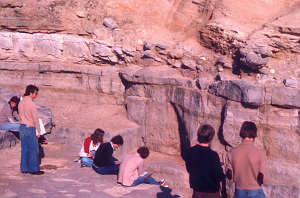The Past as key to the Present
How an ancient beach can contribute to the debate on global warming
GEOFFREY POOLE MA
Lecturer, Consultant Geomorphologist
Member of the British Society for Geomorphology
I stand on an ancient beach perched on a cliff top at Portland Bill. It's a bit
strange perched there, it could easily be an off-cut of Chesil Beach itself but
for that. The sea, 12 metres below, has stood almost constant at that level for
about 6000 years. With an almost a biblical convergence those 6000 years have
coincided with the culture of 'modern' man, his explorations, discoveries,
technology, religions, literatures, science, art, music, wars.
 |
| Raised beach, Portland Bill, Dorset |
But that sea level too is perched, perched in time. Go back another 6000 years to 12000 BP (before the present) and the sea was about 37 metres lower than today - wrong time to locate a London. Go back a further 6000 years to 18000 BP it was about 90 metres lower. Would have to cross an abandoned sea floor to the Scillies for a paddle in the sea.
Memo- 'I must go out to buy some low energy light bulbs.'
For the sea to meet up with my beach again, I would have to track back 100,000 years across frozen landscapes and ice sheets to the higher sea levels of an 'interglacial' - those warmer periods of climate between ice advances. Then, coral reefs were growing under the surface of warmer oceans while beaches like mine fringed other shores; now they lie stranded above to-day's seas, islands in the sun. (Maldives in??? - note other slight changes)
Could the sea come back once more to refresh them?
Some think so.
Could it fall again?
Some think probably.
I think I'll just forget the light bulbs.
